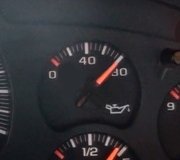Hi,
If this happens when the engine is off, that isn't from oil pressure. We have one of two issues that are both related to crankcase pressure.
First, (and keep your fingers crossed this is it) the PCV valve or hose to it may be plugged. The PCV allows excessive crankcase pressure to be drawn back into the intake manifold and burned. It is normal for a certain amount of crankcase pressure to exist. However, as the engines wear, more and more compressed air bypasses the piston rings simply due to wear. That pressure goes into the crankcase and is referred to as blow-by.
Now, the blow-by should be controlled by the PCV. So, let's start by checking and repairing that if it is plugged.
Here is what I need you to do. Between the intake manifold and the valve cover, there is a hose. See pic 1. Remove that hose and see if it is clear. Make sure air can flow through it.
If it is clear, connect the hose back to the intake side only and plug the opposite end of the hose so the engine can run. You can use a bolt or anything that can't be drawn into the engine but will plug the hose. Start the engine. Is there pressure coming out from the valve cover? If there isn't, the valve cover will need to be removed and cleaned.
If there is pressure, remove the plug from the hose to the intake. Place your thumb over the hose and have a helper start the engine. Confirm there is a vacuum on that hose. When you remove your thumb, don't be surprised if the engine stalls simply because that will be producing a large vacuum leak.
Okay, if the vacuum is good, the air can escape from the valve cover, and the hose is not plugged, then we have excessive blow-by caused by engine wear.
Let me know what you find or if you have other questions.
Take care,
Joe
PS: I hope that made sense.
Image (Click to make bigger)
Sunday, December 27th, 2020 AT 10:41 PM

